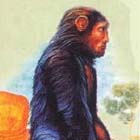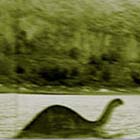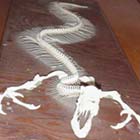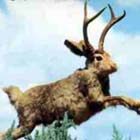There are many other strange creatures (or cryptids as the fans and researchers would call them) that are still to be discovered. Some are already legends and others we do not yet know anything about. Some have been disproven and others have turned out to be all too real. Cryptozoologists are always on the hunt trying to prove the existense of these creatures once and for all.
These researchers will someday be able to verify the existence of some of these legendary creatures while those that are not verified will surely continue to exist as beloved legends.
Kraken
Kraken are legendary sea monsters of gargantuan size, said to have dwelled off the coasts of Norway and Iceland. The sheer size and fearsome appearance attributed to the beasts have made them common ocean-dwelling monsters in various fictional works (see Kraken in popular culture). The legend may actually have originated from sightings of real giant squid that are estimated to grow to 13 metres (46 feet) in length, including the tentacles. These creatures normally live at great depths, but have been sighted at the surface and reportedly have "attacked" small ships. (cited from Wikipedia)
Yeti
The Yeti apelike animal said to inhabit the Himalaya region of Nepal and Tibet. The names Yeti and Meh-Teh are commonly used by the people indigenous to the region, and are part of their history and mythology.
Most mainstream scientists, explorers and writers consider current evidence of the Yeti's existence to be weak and better explained as hoax, legend or misidentification of known species. Nevertheless, the Yeti remains one of the most famous creatures of cryptozoology. (cited from Wikipedia)
Yowie
In a modern context, Yowie is the generic (and somewhat affectionate) term for the unidentified hominid reputed to lurk in the Australian wilderness. It is an Australian cryptid analogous to the Himalayan Yeti and the North American Bigfoot.
Rather confusingly, Yowie (or "Yowie-Whowie") is also the name of a completely different mythological character in native Australian Aboriginal folklore. This version of the Yowie is said to be a bizarre, hybrid beast resembling a cross between a lizard and an ant. It emerges from the ground at night to eat whatever it can find, including humans. This creature's characteristics and legend are sometimes interchangeable with those of the bunyip.
The origin of the term "Yowie" in the context of unidentified hominids is unclear. Some presume that it simply arose through confusion with the aforementioned Aboriginal legend. On the other hand, Jonathan Swift's yahoos from Gulliver's Travels are sometimes cited as a source. The word "Yowie" was also apparently a slang term for the Orang-utan in Victorian England.
(cited from Wikipedia)
Mokèlé-mbèmbé
Mokèlé-mbèmbé is the name given to a large creature reported to live in the lakes and swamps of the Congo River basin. The term "Mokèlé-mbèmbé" comes from the Lingala language, and can be roughly translated as “one who stops the flow of rivers.” (Clark, 261)
The creature's very existence and identification have long been debated between mainstream scientists, local Pygmies, creationists and cryptozoologists. Most controversially, it has been suggested that the creature might be a relict sauropod which somehow survived extinction. This idea has seen very little attention or support from scientists, who tend to argue that the creature can be best explained as some combination of fraud, folklore and misidentification of other animals. (cited from Wikipedia)
Tatzelwurm
The Tatzelwurm is a worm-like cryptid, reported to live in the several areas of Europe, including the Austria, Bavaria and Switzerland Alps. In some circles, it is classified as a variety of lesser dragon. It is sometimes also described as being vaguely cat-like, often attacking sheep.
Reports indicate that the creature has a snake-like body between 2 and 6 feet in length, with two clawed front legs, but no hind legs. Local folklore holds that the Tatzelwurm is able to defend itself by expelling poisonous fumes that are capable of killing a human.
One claimed photograph of the Tatzelwurm exists, it was taken in 1934 by Swiss photographer named Balkin who took a photo of what he thought was a very peculiar log. When the camera flashed, the "log" darted away.
(cited from Wikipedia)
Jackalope
The jackalope — also called an antelabbit, aunt benny, Wyoming thistled hare or stagbunny — in folklore is said to be a cross between a jackrabbit and an antelope (hence the name), goat, or deer, and is usually portrayed as a rabbit with antlers. Some believe that the tales of jackalopes were inspired by sightings of rabbits infected with the Shope papillomavirus, which causes the growth of horn- and antler-like tumors in various places on the rabbit's head and body. Images On the other hand, the human imagination has often delighted in creating composites made from two or more animals (such as the griffin and chimera), and does not really need a logical reason to do so. One common southwestern species of jackrabbit is called the antelope jackrabbit, because of its ability to run quickly like an antelope; it would have been easy enough to imagine instead (for comic effect) that this jackrabbit had the horns of an antelope. (cited from Wikipedia)





